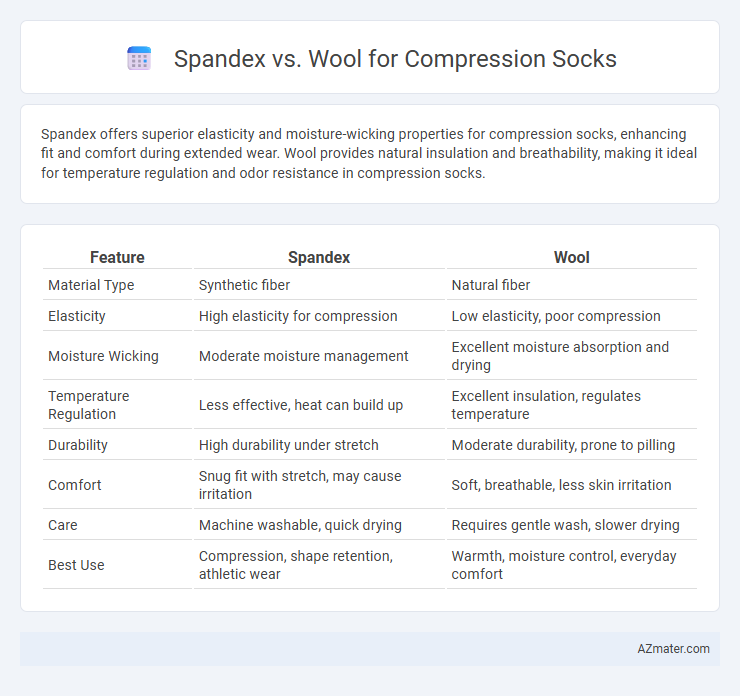Spandex offers superior elasticity and moisture-wicking properties for compression socks, enhancing fit and comfort during extended wear. Wool provides natural insulation and breathability, making it ideal for temperature regulation and odor resistance in compression socks.
Table of Comparison
| Feature | Spandex | Wool |
|---|---|---|
| Material Type | Synthetic fiber | Natural fiber |
| Elasticity | High elasticity for compression | Low elasticity, poor compression |
| Moisture Wicking | Moderate moisture management | Excellent moisture absorption and drying |
| Temperature Regulation | Less effective, heat can build up | Excellent insulation, regulates temperature |
| Durability | High durability under stretch | Moderate durability, prone to pilling |
| Comfort | Snug fit with stretch, may cause irritation | Soft, breathable, less skin irritation |
| Care | Machine washable, quick drying | Requires gentle wash, slower drying |
| Best Use | Compression, shape retention, athletic wear | Warmth, moisture control, everyday comfort |
Introduction to Compression Socks
Compression socks, designed to improve blood circulation and reduce swelling, commonly use materials like spandex and wool to balance elasticity and comfort. Spandex offers high stretchability and moisture-wicking properties, making it ideal for firm compression and durability. Wool provides natural insulation and breathability, ensuring temperature regulation and softness during extended wear.
Overview of Spandex and Wool Fibers
Spandex fibers offer exceptional elasticity and durability, making them ideal for compression socks that require consistent pressure and flexibility throughout the day. Wool fibers provide natural moisture-wicking, temperature regulation, and breathability, creating a comfortable environment for extended wear. Combining spandex and wool in compression socks balances stretchability with thermal comfort, enhancing overall performance and wearability.
Breathability: Spandex vs Wool
Wool offers superior breathability for compression socks due to its natural moisture-wicking and temperature-regulating properties, keeping feet dry and comfortable during extended wear. Spandex, while providing excellent stretch and compression support, lacks the breathable qualities of wool and can retain heat and moisture. Choosing wool-blend compression socks ensures enhanced ventilation and moisture management, making them ideal for long-term comfort.
Moisture Wicking Capabilities
Spandex offers limited moisture-wicking capabilities, primarily providing stretch and flexibility rather than moisture management in compression socks. Wool, especially merino wool, excels in moisture-wicking by absorbing sweat while maintaining breathability, keeping feet dry and comfortable during extended wear. Its natural fibers regulate temperature and reduce odor, making wool a superior choice for moisture control in compression socks compared to spandex.
Comfort and Fit Comparison
Spandex offers superior elasticity and stretch, allowing compression socks to contour closely to the foot and calf for a snug, comfortable fit that maintains consistent compression throughout wear. Wool, while providing excellent moisture-wicking and temperature regulation, lacks the same degree of stretch, potentially resulting in a looser fit that can reduce the effectiveness of compression. Combining spandex with wool in compression socks often delivers optimal comfort by balancing breathability, warmth, and a secure fit.
Durability and Longevity
Spandex offers exceptional elasticity and resilience, maintaining compression strength over extended wear and repeated washes, which enhances durability in compression socks. Wool, while naturally antimicrobial and moisture-wicking, tends to lose elasticity faster and is more prone to pilling and wear over time, reducing the sock's overall longevity. Combining spandex with wool fibers can optimize durability and comfort, providing long-lasting compression benefits without sacrificing breathability.
Odor Control Features
Spandex compression socks enhance fit and flexibility but lack inherent odor control properties, often requiring antimicrobial treatments to prevent bacterial buildup. Wool compression socks naturally regulate moisture and possess lanolin, providing superior odor resistance by inhibiting the growth of odor-causing bacteria. Choosing wool for compression socks offers optimal odor control benefits, especially for prolonged wear and high-activity levels.
Skin Sensitivity and Allergies
Spandex in compression socks offers high elasticity and snug fit but may cause irritation or allergic reactions for individuals with sensitive skin due to synthetic fibers. Wool fibers provide natural moisture-wicking and breathability, reducing the risk of skin irritation and allergies, making it ideal for sensitive or allergy-prone skin. Choosing wool-based compression socks can enhance comfort and minimize skin sensitivity issues compared to spandex blends.
Maintenance and Care Requirements
Spandex compression socks require gentle washing in cold water and air drying to maintain elasticity and prevent fabric damage. Wool compression socks need careful hand washing with mild detergent to preserve natural fibers and avoid shrinkage, while also benefiting from air drying away from direct heat. Proper maintenance extends the lifespan of both materials, ensuring consistent compression and comfort during use.
Choosing the Best Material for Your Needs
Spandex offers superior elasticity and moisture-wicking properties, making it ideal for compression socks that require a snug fit and breathability during extended wear. Wool provides natural insulation, odor resistance, and cushioning, which benefits those needing warmth and comfort in colder environments. Selecting the best material depends on your activity level, climate, and sensitivity to fabrics, with spandex favored for active use and wool preferred for temperature regulation and softness.

Infographic: Spandex vs Wool for Compression Sock
 azmater.com
azmater.com